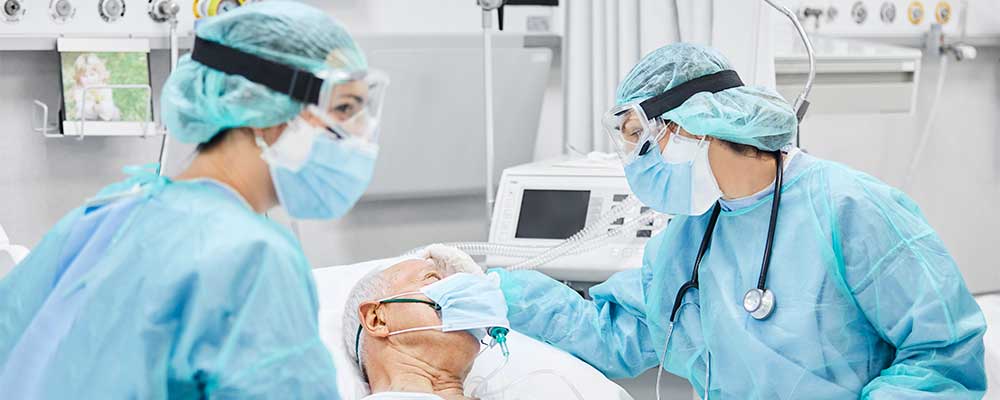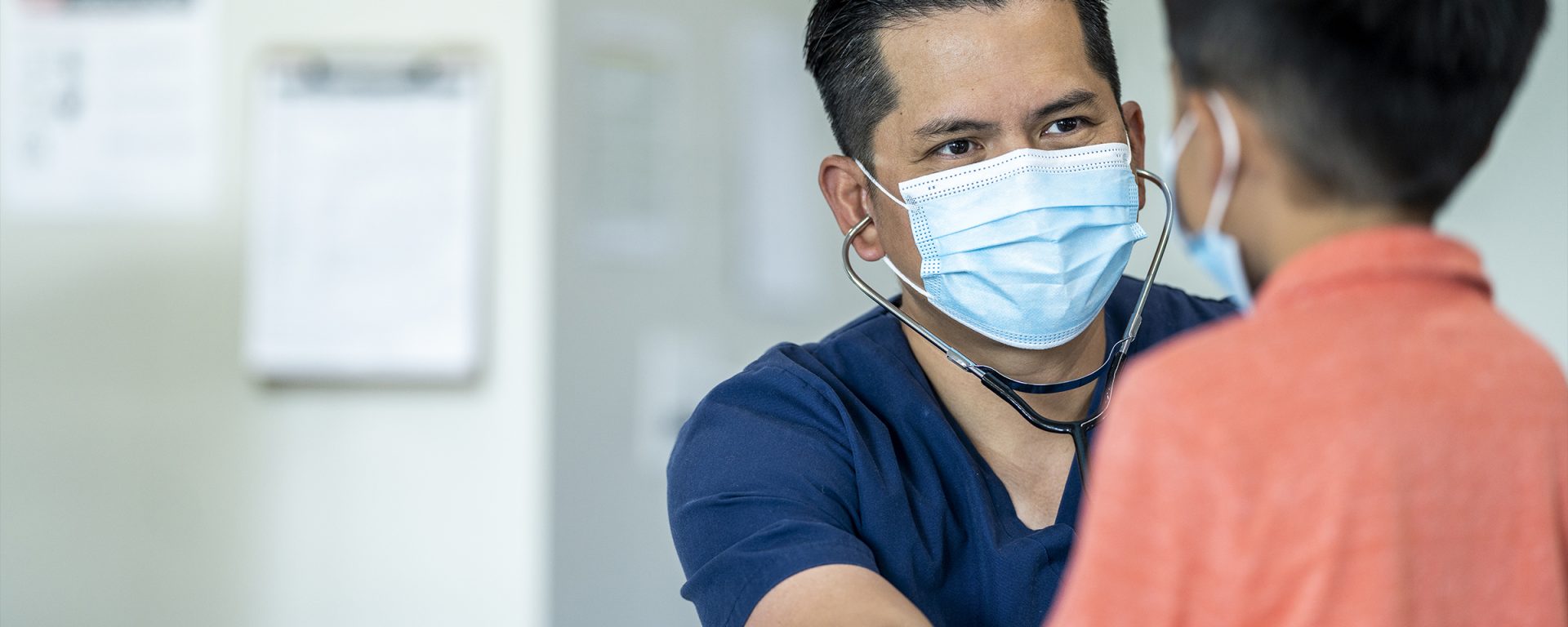The rapid spread of the COVID-19 pandemic took the world by surprise. In a few months, we went from an economically thriving, fast-paced and progressive nation to a complete standstill. While countless industries were forced to cease operations – the healthcare industry in Australia continued. A system that has proved to be the glue that’s holding communities together, right throughout the world.
But how did the Australian healthcare system really cope with this once-in-a-century event? And what might the future hold for it in a post-pandemic world?

Stewart Dowrick, Chief Executive of the Mid North Coast Local Health District and Charles Sturt Honorary Doctor, shares a fresh perspective on the events that have unfolded over the course of the pandemic.
Let’s find out from the person at the centre of one of our local health districts for an insider’s look at the pandemic.
The healthcare industry in Australia: pre-COVID
Unbeknown to some – and long before the pandemic had reached our shores – the Australian healthcare system was preparing. Well before impromptu lockdowns, mask-wearing and social distancing became the ‘new normal’ – there was a plan. A pandemic response plan.
But how prepared was the Australian healthcare system for the crisis that unfolded? And how did we measure up against the rest of the world?
“Australia pre-COVID, I think by lots of measures, has one of the world’s best healthcare systems. It’s a federated model with a really strong private sector. We have state and commonwealth government responsibilities. There are always challenges with all those models and systems – nothing is perfect. But I think by lots of measures Australia has been regularly rated in the top five health systems in the world. For equity and access in particular. We had a pretty sound system before the pandemic.”
Preparing for the unexpected
A pandemic seems like the unthinkable – until it becomes a grim reality. But how do you prepare for the unknown or the unexpected? We put the ultimate question to Stewart: was Australia’s healthcare system prepared for a pandemic? And how prepared were we really?
“I would think across Australia it would be the same – but every local health district or local health authority would have pandemic plans. New South Wales had a pandemic plan in place for such scenarios. Nothing could prepare us for the COVID situation because it was so unique.”
Given our generation hasn’t experienced a health crisis of this scale, what measures and plans were in place?
“We’ve had plans based upon SARs and all the other things we’ve had before – swine flu – which we used the plans for in the past 15–20 years. So we used that as a baseline, but again, it probably brought to our attention some of the short-comings in that – given the breadth of it. We’re talking about a one-in-one-hundred-year situation. There were definitely plans in place so that we could respond and that could get us ready so that we could work our way through the situation.”
The system that never rests
While countless industries closed their doors, our healthcare sector sprang into action. Shift after long shift, our healthcare heroes reported for duty. And this wasn’t the only battle endured by frontline healthcare workers in recent times.
“Pre-COVID, our region had been through some catastrophic bushfire situations where our teams had been working in some of the most extreme conditions across the Mid North Coast. Good or bad, our system requires us to be open 24/7. So the initial impact was responding to that. Another response that occurred was when the Victorian situation reached its peak. We had to also respond to the Avalon situation and in the northern beaches in a different way. But again, it was looking at our staff and saying: are they safe?”
We had to be ready. We were at the frontline and we couldn’t shut our doors.
Life on the frontline of the healthcare industry in Australia
Life on the frontline of Australian healthcare services. It was the picture of perseverance. After months working under the most arduous of conditions – with no end in sight – the pandemic had well and truly taken its toll.
“As we saw around the whole world, health has such a dedicated workforce. A workforce committed to their patients. And I think we were no different from that. They were very capable, professional and committed. However, in saying that, they were stressed as well, about what could happen to them.
“We were learning and despite having our best plans in place, things were constantly evolving. In the context of this changing environment we also had healthcare workers with family members affected by COVID – and weren’t able to see them. Or not being able to be with their families for days on end because they had to work in the healthcare setting.”
There was a huge impact, at times an emotional impact. But their commitment was second-to-none and world-class. And I think we should commend them for what they did in a very stressful situation.
Impacts on community access to healthcare
With mask-wearing mandated in parts of the country, and sporadic orders to ‘stay home’, how did communities respond to the new norm?
“I think our communities were terrific. They realised that we were in this situation that none of us had seen before. And we reduced considerably a range of services like dental care and surgery, for example. We could still do operations for emergency and urgent elective surgery, of course. But breast screening services literally ceased. Dental services ceased because of the potential spread of COVID.”
“But it also saw us look at providing greater online and telehealth services. Antenatal services, which used to be in a class setting, were now delivered by Teams or by Skype. Our team of health professionals did respond as best as they could. But in some cases, like dental or elective surgery, there were no doubt impacts there on people.”
The healthcare crisis created opportunities for different services to come together.
“The really good thing about how we adapted, was that we found new ways of working with our healthcare partners in a way that we had never done before. We acted as a regional partner and worked closely with the private hospital group. Though different, our private healthcare partners fully cooperated with us to provide healthcare services. Another good example of this was through bushfire situation just a few months before that. Those relationships only got stronger. I think our community saw us, regardless of funding base, everyone worked much closer together.”

Strategic direction: moving forward
How does the healthcare system intend on working through some of the issues created by the pandemic? And what will be some areas of focus?
“We’ll use elective surgery as an example. We’re all working together to reduce the long waits that were created during that period. There are state contracts with private hospital groups, we’re accessing their theatre capacity with our surgeons, anaesthetists and clinical teams. That’s a really good example of the short to medium-term. Will this be there long-term? Probably not because things will go back to how they were before.”
“Having a really strong private system and public system. The other thing about looking at the short and long-term is our connection with the aged care sector. We need to maintain the momentum of the strengthened relationships we have seen during COVID. We have 33 aged care facilities on the Mid North Coast that worked with us. And I think those relationships were there and that might help us support them with how they care for their patients. It also helps us with how we will work with that cohort of elderly people into the future in a way that we haven’t done before. There’s a great opportunity there.”
Time to redesign the healthcare industry in Australia?
To redesign, or to stay the same. That is the question. But what, if anything, have we learned from the structure of the nation’s healthcare system. Is there an opportunity to redesign Australia’s healthcare system?
“We are always improving. And technology is helping with the way we do business all the time. But also the way we provide care, pathways and research is helping us to do things differently. I think there’s an opportunity for governments to maybe explore different ways of redesigning our system. Whether it’s through better collaboration and supporting that regionally or in a metropolitan sense. Mental health could be a way they might want to look at how all the partners come together differently and support in a collaborative way.
I think telehealth and virtual health will be here to stay. There was uptake with our GPs who embraced it. And that was a way they redesigned their work. I think it’s embracing that and looking at the funding models that sit around that. It needs to be carefully thought out.
Resourcing the future of Australian healthcare
With all eyes on the future of Australian healthcare, what can we expect to see resource-wise? Will hospital budgets be increased?
“In regards to COVID, I’d say across the nation every local health authority has received considerable funding to support them during the COVID-19 response. Whether it’s to increase our expenditure on PPE, or surgery, or the COVID clinics we’ve seen set up, or the vaccination programs or equipment we need. So, there’s definitely a short-term, which might be a little bit medium-term too. We don’t know how long we’ll be in this situation for.”
“The government and treasurer have been very supportive of the healthcare industry in Australia. The challenge to all of us is: can the lessons we learn help us use the dollars we have differently and more wisely? Rather than using virtual or telehealth, using hospitals at home in a different way – because people did seem to adapt to that – but only if it’s appropriate clinically.”
To centralise or decentralise?
Throughout the pandemic, it was almost impossible to keep up with changes mandated at the state level. Borders opened and closed. Restrictions were enforced then lifted. Then enforced again. But, is there the opportunity to centralise or decentralise decision-making within Australia’s healthcare system? Could further centralisation streamline and make things run smoother?
“I think when we get through all of this – many people – each state and territory – will look at their own models of how they set up their local health districts. NSW has responded very well to the COVID-19 pandemic. I think that’s beyond doubt that we’ve done very well with a model that suits us and works for us. We’ve got 15 local health districts that have a degree of autonomy but also a degree of centralisation supporting us. We aim to work as a system and we have operated as a system, especially in the public health response. Which has been A-plus gold standard how we’ve responded there. Other states might want to look at that but you’ve got to look at your own context.”
New and evolving roles in Australian healthcare
So, what could the future hold for workers in the healthcare industry in Australia? Will the impact of COVID result in any new and evolving roles?
“Yes, I think there will definitely be new roles. I think that we’ll see areas of research – virtual care – will become something we’ll want to explore differently. I know some districts are looking at virtual care and the people at home who they support. ‘Hospitals’ in the home – being one of their bigger hospitals – bigger than it is now. I do think that people are creating formal structures around that. Like they haven’t done before.”

Protecting the heroes of the healthcare industry in Australia
Dressing from top to toe in PPE could be here to stay for some of our healthcare heroes. That is, until the pandemic is over. And so too is ongoing training and upgrading the skills of allied health workers.
“The skill sets of our people have been wonderful. They’ve been applied, they’ve experienced, they’ve learned a lot over the past year. Our frontline teams have been terrific. The skills of our people and how we operate and work together in an environment where most likely an emergency department staff will have to wear PPE for a considerable amount of time – if not forever. So that was new to them. And in environments like ICU, they’ll probably have to operate in more of a PPE environment than they did before. There’s a fatigue part to that, the skill set to make sure we can put equipment on safely. How we set up our electronic medical records is being done differently as well so I definitely see that skill set changing but also improving.”
What we can learn from Australia’s response to the pandemic
There are some valuable lessons to be learned – the good and the bad – when we are faced with extreme events like the global pandemic.
“I don’t think we realise how quickly we responded during that and we need to embrace that during this period. We need to be prepared to make change. We actually experienced a lot of change quite quickly. The healthcare industry in Australia likes change – it’s gradual – but we saw it here in the pandemic with how quickly we responded. We did it in a way where we were agile and made decisions promptly. I think they are some of those take-home messages that are important for all of us. And our communities were fantastic. It just reminds us that the focus on the patient was always there.”
“Aged care, Aboriginal medical services, police, local government – have all been very willing to cooperate with us and I think that’s a good thing for all of us going into the future – that greater cooperation. I think people realise the professionalism of the healthcare sector – if they didn’t realise before, I think we have an incredibly talented, well-trained group of workers.”
A final word of advice
And Stewart’s final parting advice?
“I think an important message is that people have listened to the good advice of public health officials during this pandemic and I think that’s helped us get to where we were, working with treasuries and governments to keep the economy going while maintaining our safety.”
“When you talk about public health, Florence Nightingale and others were teaching us in the 1880s about washing our hands and I still think that sometimes we forget about those little basics in life. It doesn’t hurt to wash our hands and sanitise. So let’s keep those things up for the future.”
I think Australia has done incredibly well for a number of reasons. We’ve still got a long journey to go – it’s not over yet.
Make a difference to the healthcare industry in Australia
Wondering how you can play your part in addressing Australian healthcare in the post-pandemic world? A career in allied health, nursing, medical sciences or medicine will give you the opportunity to positively impact regional and rural healthcare. Explore our wide range of courses to find the right career path for you. With Charles Sturt, you can help change the world.


You must be logged in to post a comment.